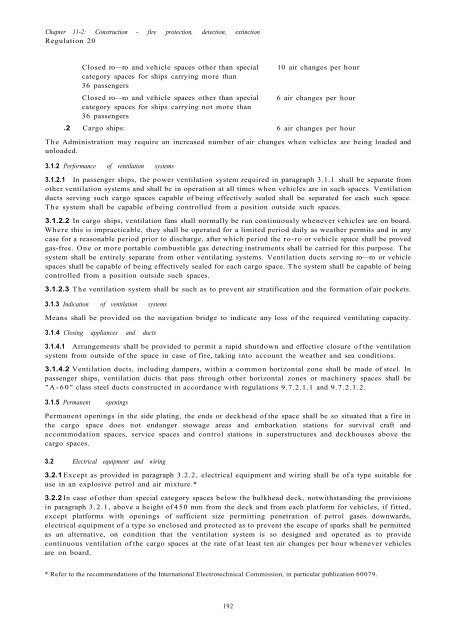Solas Consolidated Edition 2009.pdf
Solas Consolidated Edition 2009 for maritime
Solas Consolidated Edition 2009 for maritime
You also want an ePaper? Increase the reach of your titles
YUMPU automatically turns print PDFs into web optimized ePapers that Google loves.
Chapter 11-2: Construction - fire protection, detection, extinction<br />
Regulation 20<br />
Closed ro—ro and vehicle spaces other than special<br />
category spaces for ships carrying more than<br />
36 passengers<br />
Closed ro—ro and vehicle spaces other than special<br />
category spaces for ships carrying not more than<br />
36 passengers<br />
10 air changes per hour<br />
6 air changes per hour<br />
.2 Cargo ships: 6 air changes per hour<br />
The Administration may require an increased number of air changes when vehicles are being loaded and<br />
unloaded.<br />
3.1.2 Performance of ventilation systems<br />
3.1.2.1 In passenger ships, the power ventilation system required in paragraph 3.1.1 shall be separate from<br />
other ventilation systems and shall be in operation at all times when vehicles are in such spaces. Ventilation<br />
ducts serving such cargo spaces capable of being effectively sealed shall be separated for each such space.<br />
The system shall be capable of being controlled from a position outside such spaces.<br />
3.1.2.2 In cargo ships, ventilation fans shall normally be run continuously whenever vehicles are on board.<br />
Where this is impracticable, they shall be operated for a limited period daily as weather permits and in any<br />
case for a reasonable period prior to discharge, after which period the ro-ro or vehicle space shall be proved<br />
gas-free. One or more portable combustible gas detecting instruments shall be carried for this purpose. The<br />
system shall be entirely separate from other ventilating systems. Ventilation ducts serving ro—ro or vehicle<br />
spaces shall be capable of being effectively sealed for each cargo space. The system shall be capable of being<br />
controlled from a position outside such spaces.<br />
3.1.2.3 The ventilation system shall be such as to prevent air stratification and the formation of air pockets.<br />
3.1.3 Indication of ventilation systems<br />
Means shall be provided on the navigation bridge to indicate any loss of the required ventilating capacity.<br />
3.1.4 Closing appliances and ducts<br />
3.1.4.1 Arrangements shall be provided to permit a rapid shutdown and effective closure of the ventilation<br />
system from outside of the space in case of fire, taking into account the weather and sea conditions.<br />
3.1.4.2 Ventilation ducts, including dampers, within a common horizontal zone shall be made of steel. In<br />
passenger ships, ventilation ducts that pass through other horizontal zones or machinery spaces shall be<br />
"A-60" class steel ducts constructed in accordance with regulations 9.7.2.1.1 and 9.7.2.1.2.<br />
3.1.5 Permanent openings<br />
Permanent openings in the side plating, the ends or deckhead of the space shall be so situated that a fire in<br />
the cargo space does not endanger stowage areas and embarkation stations for survival craft and<br />
accommodation spaces, service spaces and control stations in superstructures and deckhouses above the<br />
cargo spaces.<br />
3.2 Electrical equipment and wiring<br />
3.2.1 Except as provided in paragraph 3.2.2, electrical equipment and wiring shall be of a type suitable for<br />
use in an explosive petrol and air mixture.*<br />
3.2.2 In case of other than special category spaces below the bulkhead deck, notwithstanding the provisions<br />
in paragraph 3.2.1, above a height of 450 mm from the deck and from each platform for vehicles, if fitted,<br />
except platforms with openings of sufficient size permitting penetration of petrol gases downwards,<br />
electrical equipment of a type so enclosed and protected as to prevent the escape of sparks shall be permitted<br />
as an alternative, on condition that the ventilation system is so designed and operated as to provide<br />
continuous ventilation of the cargo spaces at the rate of at least ten air changes per hour whenever vehicles<br />
are on board.<br />
* Refer to the recommendations of the International Electrotechnical Commission, in particular publication 60079.<br />
192


